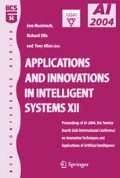Abstract
Case Based Reasoning (CBR) systems solve new problems by reusing solutions of similar past problems. For knowledge intensive tasks such as design it is not sufficient to merely retrieve and present similar past experiences. This is because the user requires an explanation of the solution in order to judge its validity and identify any deficiencies. Case retrieval with k-nearest neighbour relies heavily on the availability of cases, knowledge about important problem features and the similarity metric. However, much of this information, utilised by the system, is not transparent to the user. Consequently there is a need for tools that can help instil confidence in the system by providing useful explanations to the user. This paper proposes an approach that explains the CBR retrieval process by visualising implicit system design knowledge. This is achieved by visualising the immediate neighbour hood and by highlighting features that contribute to similarity and to differences. The approach is demonstrated on a pharmaceutical tablet formulation problem with a tool called FormuCaseViz. An expert evaluation provides evidence to support our approach.
Access this chapter
Tax calculation will be finalised at checkout
Purchases are for personal use only
Preview
Unable to display preview. Download preview PDF.
References
M. Ankerst, S. Berchtold, and D. A. Keim. Similarity clustering of dimensions for an enhanced visualization of multidimensional data. In Proceedings of IEEE Symposium on Information Visualization, pages 52–60. IEEE Computer Society Press, 1998.
R. Bergmann. Experience Management: Foundations, Development Methodology, and Internet-Based Applications. Springer, 2002.
S. M. Craw, N. Wiratunga, and R. Rowe. Case-based design for tablet formulation. In Proceedings of the 4th European Workshop on Case-Based Reasoning, pages 358–369. 1998.
P. Cunningham, D. Doyle, and J. Loughrey. An evaluation of the usefulness of case-based explanation. In Proceedings of the 5th International Conference on Case-Based Reasoning, pages 122–130. Springer, 2003.
G. Falkman. The use of a uniform declarative model in 3D visualisation for case-based reasoning. In Proceedings of the 6th European Conference on Case-Based Reasoning, pages 103–117. Springer, 2002.
A. Hotho, S. Staab, and G. Stumme. Explaining text clustering results using semantic structures. In Principles of Data Mining and Knowledge Discovery, 7th European Conference, pages 217–228. Springer, 2003.
A. Inselberg. The plane with parallel coordinates. The Visual Computer, 1:69–91, 1985.
R. King, C. Feng, and A. Sutherland. Statlog: comparison of classification algorithms on large real-world problems. Applied Artificial Intelligence, 9(3):259–287, 1995.
J. Kolodner. Case-Based Reasoning. Morgan Kaufmann, San Mateo, CA, 1993.
D. B. Leake. CBR in context: The present and future. In D. B. Leake, editor, Case-Based Reasoning: Experiences, Lessons and Future Directions, pages 3–30. MIT Press, 1996.
G. P. McArdle and D. C. Wilson. Visualising case-base usage. In Workshop Proceedings of the 5th International Conference on Case-Based Reasoning, pages 105–124. NTNU, 2003.
D. McSherry. Explanation in case-based reasoning: an evidential approach. In Proceedings of the 8th UK Workshop on Case-Based Reasoning, pages 47–55. 2003.
M. Richter. Introduction. In M. Lenz, B. Bartsch-Sporl, and S. Wess, editors, Case-Based Reasoning Technology: From Foundations to Applications, pages 1–15. Springer, 1998.
R. Southwick. Explaining reasoning: an overview of explanation in knowledge-based systems. Knowledge Engineering Review, 6:1–19, 1991.
Author information
Authors and Affiliations
Editor information
Editors and Affiliations
Rights and permissions
Copyright information
© 2005 Springer-Verlag London Limited
About this paper
Cite this paper
Massie, S., Craw, S., Wiratunga, N. (2005). A Visualisation Tool to Explain Case-Base Reasoning Solutions for Tablet Formulation. In: Macintosh, A., Ellis, R., Allen, T. (eds) Applications and Innovations in Intelligent Systems XII. SGAI 2004. Springer, London. https://doi.org/10.1007/1-84628-103-2_16
Download citation
DOI: https://doi.org/10.1007/1-84628-103-2_16
Publisher Name: Springer, London
Print ISBN: 978-1-85233-908-1
Online ISBN: 978-1-84628-103-7
eBook Packages: Computer ScienceComputer Science (R0)

